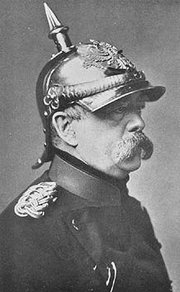Pickelhaube
|
|

| This article is part of the hats and headgear series: |
| Overview of headgear |
| Hats; Bonnets; Caps |
| Hoods; Helmets; Wigs |
| Masks; Veils; Scarves |
| Tiaras; Papal tiaras |
| Crowns; Types of crowns |
| List of hats and headgear |
The pickelhaube (German Pickel = "point"; Haube = literally "bonnet", a general word for headgear) is a spiked helmet worn in the 19th century by German military forces. The famous spike is said to have been a feature to protect the infantrymen against sabre-blows by cavalry.
The pickelhaube was originally designed in 1842 by King Frederick William IV of Prussia. and its use slowly spread to other German principalities. In 1887, the Kingdom of Bavaria was the last German state to adopt the pickelhaube. Several other nations adopted the pickelhaube or at least something very similar.
The basic pickelhaube was made of leather with metal reinforcements and the metal point. All-metal versions of the pickelhaube were worn mainly by cuirassiers, and often appear in portraits of high-ranking military and political figures (such as Otto von Bismarck on this page).
During World War I it was found that the leather helmet offered little protection to troops in the trenches. In 1916 it was slowly replaced by the Stahlhelm or "steel helmet" that would still be worn by German troops in World War II. The pickelhaube was reduced to ceremonial wear. With the collapse of the German Empire in 1918, the pickelhaube was completely abandoned, but even today it continues to be an important part of a clichéd mental picture of Germans, especially in Britain.
External links
- More Pickelhaube Information (http://www.coljs.com)
- Evolution of the pickelhaube (http://www.kaisersbunker.com/pe/pe.htm)
- Evolution of the stahlhelm (http://www.german-helmets.com/)de:Pickelhaube
